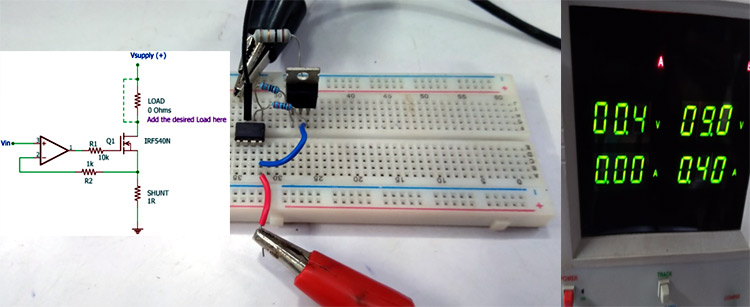
In a voltage-controlled current source circuit, as the name implies, a small amount of voltage across the input will proportionally control the current flow across the output loads. This current source circuit using an op amp is commonly used in electronics to drive current-controlled devices like BJT, SCR, etc. We know that in a BJT, the current flowing through the base of the transistor controls how much the transistor is closed. This base current can be provided by many types of circuits; one method is to use this voltage-controlled current source circuit. You can also check the constant current circuit, which can also be used to drive current-controlled devices.
This comprehensive guide demonstrates how to design and build a voltage controlled current source using op amp with practical examples. This type of voltage-controlled current source circuit is also called a current servo. The circuit is very simple and can be constructed with a minimum number of components.
Table of Contents
- What is a Voltage Controlled Current Source Using Op Amp?
- └ Op-Amp Operating Principle
- Formula and Calculations
- └ Mathematical Formula for Current Control
- Diagram and Circuit Design
- Example - Step by Step Construction
- └ Component Selection
- └ Required Components List
- The Working
- Performance Verification
- Circuit Improvements and Design Considerations
- Frequently Asked Questions
- Essential Voltage Circuits to Build On
What is a Voltage Controlled Current Source Using Op Amp?
To understand the working of this circuit, it is essential to know how an operational amplifier works. A voltage controlled current source using op amp converts an input control voltage to output current regardless of load variations. To design current source circuits, one must know the basics of operational amplifiers.
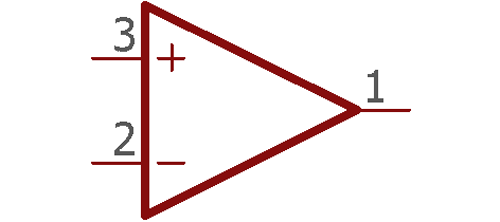
The above image is a single operational amplifier. An amplifier amplifies signals, but other than amplifying signals it can also do mathematical operations. An op-amp or Operational Amplifier is the backbone of Analog Electronics and is used in many applications, such as Summing amplifiers, differential amplifiers, Instrumentation amplifiers, Op-Amp integrators, etc.
Op-Amp Operating Principle
If we look closely at the above image, there are two inputs and one output. Those two inputs have + and - sign. The positive input is called as noninverting input, and the negative input is called the inverting input.
The first rule the amplifier used to work is to make the difference between these two inputs always zero. For better understanding, let's see the image below

The above amplifier circuit is a voltage follower circuit. The output is connected to the negative terminal, making it a 1x gain amplifier. Therefore, the voltage given across the input is available across the output.
As discussed before, the operational amplifier makes the differentiation between the input and 0. As the output is connected across the input terminal, the op-amp will produce the same voltage that is provided across the other input terminal. So, if 5V is given across the input, as the amplifier output is connected at the negative terminal, it will produce 5V, which eventually proves the rule 5V – 5V = 0. This happens for all negative feedback operations of amplifiers.
Op-Amp Current Source Circuit Formula and Calculations
By the same rule, let’s see the circuit below.
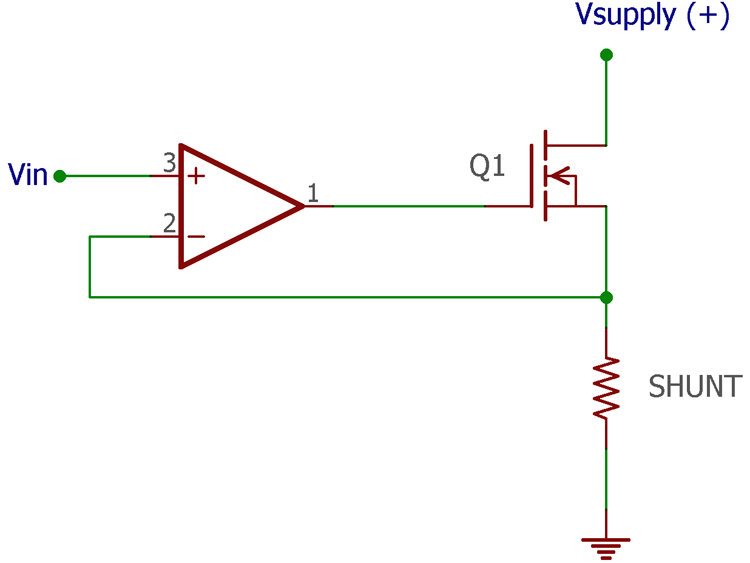
This op-amp with current source example shows how negative feedback is derived from the shunt resistor connected across an N-channel MOSFET. The op-amp output is connected across the MOSFET gate.
Mathematical Formula for Current Control
Let’s assume, 1V input is given across the positive input of the op-amp. The Op-amp will make the negative feedback path 1V at any cost. The output will turn on the MOSFET to get 1V across the negative terminal. The rule of the shunt resistor is to produce a drop voltage as per Ohm's law, V=IR. Therefore, a 1V drop voltage will be produced if 1A of current flows through the 1-ohm resistor.
The op-amp will use this drop voltage and get the desired 1V feedback. Now, if we connect a load that requires current control for operation, we can use this circuit and place the load at an appropriate location.
Voltage Controlled Current Source Diagram and Circuit Design
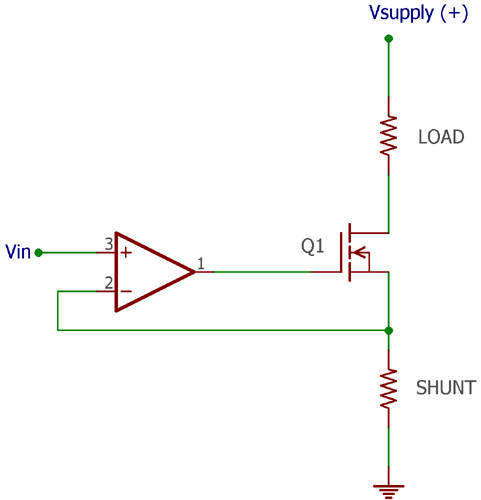
The detailed circuit diagram for the Op-Amp Voltage controlled current source can be found in the image below –
Op-Amp with Current Source Example - Step by Step Construction
To construct this circuit, we need an op-amp. LM358 is a very cheap, easy-to-find op-amp, and it is a perfect choice for this project; however, it has two op-amp channels in one package, but we need only one. We have previously built many LM358-based circuits; you can also check them out. The image below is an overview of the LM358 pin diagram.
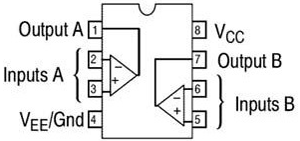
Component Selection for Current Source Circuit
Next, we need an N Channel MOSFET; for this IRF540N is used. Other MOSFETs will also work, but make sure that the MOSFET package has an option to connect an additional heat sink if required and careful consideration is needed for selecting the appropriate specification of the MOSFET as required. IRF540N pinout is shown in the image below –
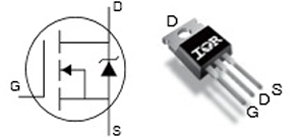
The third requirement is the shunt resistor. Let's stick into 1ohms 2-watt resistor. An additional two resistors are required, one for the MOSFET gate resistor and the other for the feedback resistor. These two are required for reducing the loading effect. However, the drop between these two resistors is negligible.
Now, we need a power source; it is a bench power supply. There are two channels available in the bench power supply. One of them, the first channel, is used to provide power to the Circuit and the other one, which is the second channel used to provide the variable voltage to control the source current of the circuit. As the control voltage is applied from an external source, both channels need to be at the same potential; thus, the ground terminal of the second channel is connected across the first channel's ground terminal.
However, this control voltage can be given from a variable voltage divider using any kind of potentiometer. In such a case, a single power supply is sufficient. Therefore, the following components are required to make a voltage-controlled variable current source -
Required Components List
- Op-amp (LM358)
- MOSFET (IRF540N)
- Shunt Resistor (1 Ohm)
- 1k resistor
- 10k resistor
- Power supply (12V)
- Power supply unit
- Breadboard and additional connecting wires
Working of the Voltage Controlled Current Source Circuit
The circuit is constructed in a breadboard for testing purposes, as you can see in the image below. The load is not connected in the circuit to make it a near-ideal 0 Ohms (shorted) for testing the current control operation.
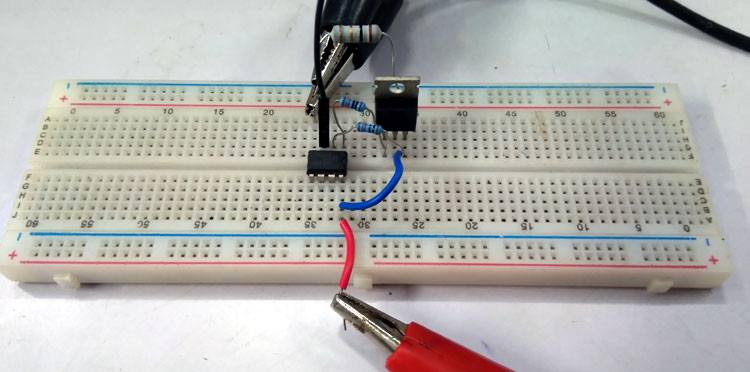
The input voltage is changed from 0.1V to 0.5V, and the current changes are reflected in the other channel. As seen in the image below, a 0.4V input with 0 current draws effectively makes the second channel draw 400mA of current at a 9V output. The circuit is powered using a 9V supply.
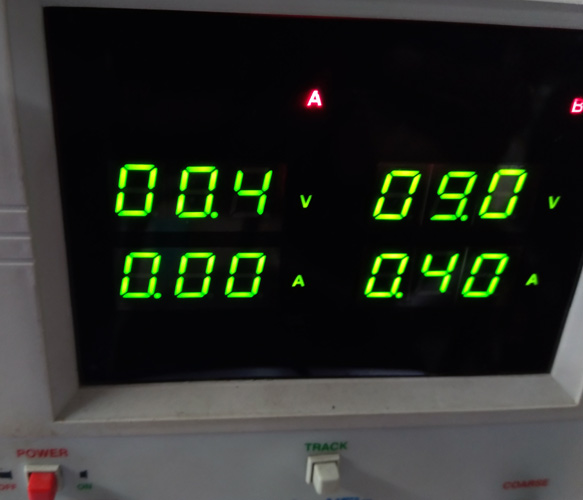
Performance Verification Using Op-Amp Current Source Formula
You can also check the video at the bottom of this page for detailed working. It responds depending on the input voltage. For example, when the input voltage is .4V, the op-amp will respond to have the same voltage .4V in its feedback pin. The output of the op-amp turns on and controls the MOSFET until the voltage drop across the shunt resistor becomes .4V.
Ohm's law is applied in this scenario. The resistor will only produce a .4V drop if the current through the resistor is 400mA (.4A). This is because Voltage = current x resistance. Therefore, .4V = .4A x 1 Ohm.
At this scenario, if we connect a load (resistive load) in series same as like described in the schematic, in between positive terminal of the power supply and the Drain pin of the MOSFET, the op-amp will turn on the MOSFET and the same amount of current will flow through the load and the resistor by producing the same voltage drop as before.
Thus, we can say that the current through the load (current is sourced) is equal to the current through the MOSFET, which is also equal to the current through the shunt resistor. Putting it in a mathematical form, we get,
Current sourced to the load = Voltage drop / Shunt Resistance.
As discussed before, the voltage drop will be the same as the input voltage across the op-amp. Therefore, if the input voltage is changed, the op amp current source through the load will also change. Hence, the Current source circuit using op amp formula is derived
Current sourced to the load = Input voltage / Shunt Resistance.
Circuit Improvements and Design Considerations
- The increase of the resistor wattage can improve the heat dissipation across the shunt resistor. To choose the wattage of the shunt resistor, Rw = I2R can be used, where Rw is the resistor wattage and I is the maximum sourced current, and R is the value of the shunt resistor.
- Same as like LM358, many op-amp ICs have two op-amps in a single package. If the input voltage is too low, the second unused op-amp can be used to amplify the input voltage as required.
- For the improvement of the thermal and efficiency issues, low-resistance MOSFETs can be used along with a proper heat sink.
Frequently Asked Questions
How does a voltage-controlled current source operate?
A voltage-controlled current source operates by using an op-amp negative feedback system to control and maintain a fixed voltage across a shunt resistor. The op-amp circuit will adjust the current flowing through the MOSFET until the voltage across the load resistor (shunt resistor) is equal to the input control voltage. This output voltage is a proportionate current through the load circuit connected to the power supply.
What is the equation for an op-amp current source?
The equation for the op-amp current source is: I_load = V_control ÷ R_shunt. Where I_load is the output current, V_control is the input voltage, and R_shunt is the value of the sensing resistor.
What components do I need for voltage voltage-controlled (VVC) current source?
The main components: Op-amp LM358, N-channel MOSFET IRF540N, shunt resistor 1Ω, gate resistor 1kΩ, feedback resistor 10kΩ and a 12V power supply.
Essential Voltage Circuits to Build On
Create a solid foundation for your analog circuit skills by exploring these core voltage-based designs. From stabilizing voltage levels to boosting and dividing them, these tutorials equip you with the building blocks needed for mastering current control applications.
Learn about the different types of voltage regulator circuits, such as Linear Voltage Regulator Circuit, Series Voltage Regulator, Shunt Voltage Regulator, Zener Voltage Regulator Circuit, Buck type, Boost type, Buck/Boost type Switching Voltage Regulator Circuit.
Voltage Tripler is the circuit where we get the thrice of the peak input voltage, like if the peak voltage of AC voltage is 5 volt, we will get 15 volt DC at the output. Generally transformers are there to step-up or step-down the voltage, but sometimes transformers are not feasible because of their size and cost.
A Voltage or Potential Divider Circuit is commonly used circuit in electronics where an input voltage has to be converted to another voltage lower than then the original.
Comments
Hello, this is a great explanation. This op amp controls so that the R Shunt voltage equals Vin, If I replace the R Load with three resistors arranged in series (sequentially Ra, Rb, Rc), and I want to make the voltage Rb (which is in the middle of the arrangement) equal to Vin, how to make it? thank you

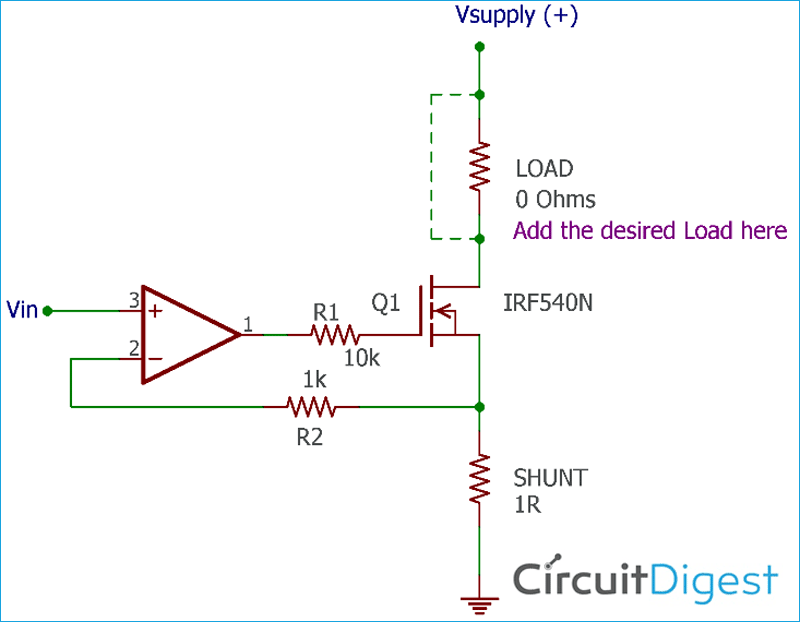
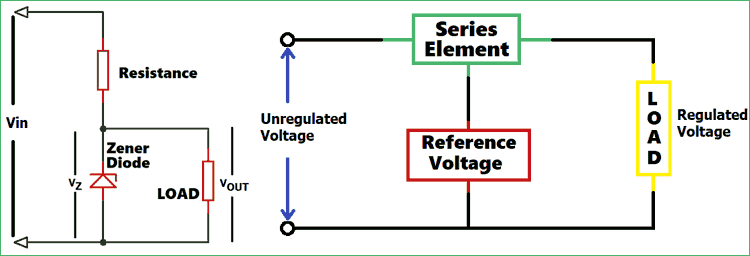
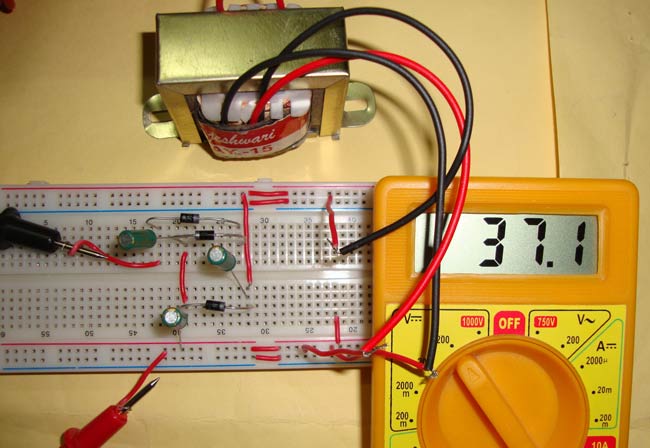






Could you help me to desing the controled constant current using a high voltaje power supply for the load like 350V and to reach only 0.5 Amp. Should I use another power supply to feed the circuit?. Thanks